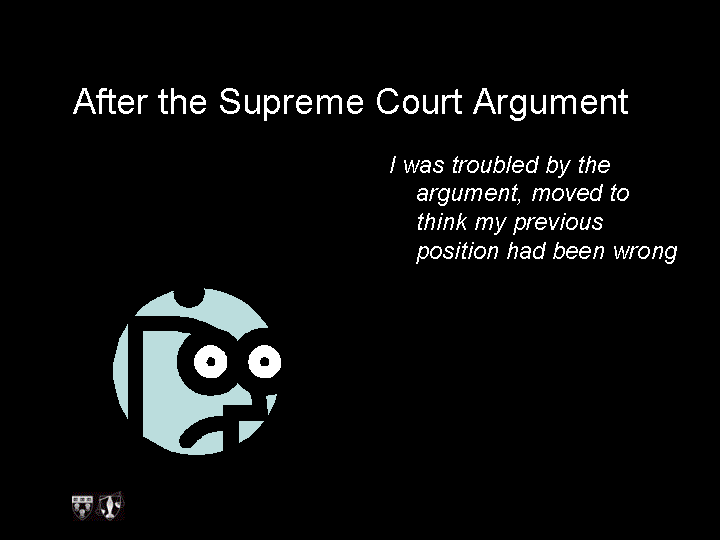
I attended the Grokster argument. High points in an excellent argument were the questions from the Justices, truly curious, intelligent questions, probing to find a way through the puzzle Grokster confronts them with. Grokster is a bad actor, like a kid taunting the police, can’t catch me, can’t catch me. 
Check out Tim Armstrong’s blog of the event, extraordinarily observant though he was in the Lawyer’s Room listening on remote. What did I see? , I saw the Justices facing a mystery,
 looking for a new way to see.
looking for a new way to see.
Day after the argument I started ruminating.

Bottom line, I’m changing my mind.
I start with conception of cyberspace as rhetorical space, made entirely of message, the connections which make the flow of message possible as fluid as pathways in a net. The Justices face the problem of applying law built for atoms to the flow of bits.
The digital environment brings together what has previously been seen as two separate domains of action. These two domains of action have generated separate and distinct legal doctrine to govern them. The Internet eliminates meaningful functional distinction between them and challenges the Supreme Court to see the digital world anew.
One action space is comprised of what law describes as direct copyright infringement, the act of making or distributing a copy of another’s legally protected work without the copyright holder’s permission. This space is mediated by the law of fair use, which strikes a distinct yet fuzzy border between legal but unlicensed copying of another’s legally protected work on one side and infringement on the other.
The second action space is comprised of behaviors the law describes as contributory copyright infringement, the act of facilitating another in making an unlicensed copy of a third party’s legally protected work. This space is governed by the Sony rule, which strikes a border between technologies which can be developed without incurring legal liability even though they facilitate infringement, and technologies which expose its developer to liability for infringement it facilitates.
The Internet eliminates functional distinction between the two. From the point of view of the user of a networked computer, whose action consists of downloading a work by clicking a mouse-pointer on a screen, it is a matter of indifference where the received sequence of bits comes from. It makes no difference to the user where the source bits are stored, or where the index that allows the user to find the source is stored or how it is made, just so long as the info is accurate and the links work.
Yet from viewpoint of the engineers behind the screen, the issue of where the bits come from is a matter of engineering choice. Differing engineering strategies are capable of delivering to the user the function of finding and downloading a digital work.
(1) The bits may come from a bulletin board — a digital library. If the work is copyrighted and the downloader is unlicensed, then the entity legally responsible for the data base hosting the bits is liable for direct copyright infringement, subject to defense of fair use. Playboy sues Frena, operator of a bulletin board to which he has invited subscribers to post and share images. Some users have posted copyrighted images of Playmates, and others users have downloaded them, notwithstanding Frena’s request to users not to post copyrighted material, and Frena’s policy of taking down allegedly infringing images immediately upon complaint. Frena is held liable for direct infringement, no matter his lack of intent to infringe or how small the amount of infringing material in proportion to the amount of non-infringing material on the bulletin board. Fair use is unavailing as a defense because Frena’s operation is commercial, neither non-profit nor educational; the copied material is artistic, not factual; the entire work is copied, not just a bit of it; and the copying may take away sales from the copyright holder. Playboy v. Frena, 839 F. Supp. 1552 (MD Fla. 1993).
(2) The bits may come from a source or sources in a peer-to-peer network. The transaction is facilitated by the producer of the technology that enables the p2p network. This facilitation exposes the producer of the technology to liability for contributory infringement, subject to defense under the Sony principle if the facilitator can show that its technology is capable of substantial non-infringing use. The purpose of the Sony principle is to protect innovation. The principle embodies the idea that a new technology should not be squelched with legal liability simply because it can be used for infringement.
View the problem from the viewpoint of a developer like Harvard seeking to build a digital library. Note, as you plan the structure of this technological development, that greater potential functionality and capacity for valuable non-infringing use brings you into the risk domain of direct infringement, where risk is very high. Note that you can play safe with much less functionality by staying in contributory infringement space, protected by the Sony principle. The law in this respect is anomalous, counterproductive, and should be changed. The law of the separate spaces should be brought together at the borders. Ask of Grokster whether fair use should shield its facilitation of infringement, even though the technology may be capable of non-infringing use. Ask of Frena and of Harvard in Frena’s wake whether their digital library is capable on substantial non-infringing use. Use the flexibility in the concept of fair use in both direct and contributory space to align the law to functionalities, not to wiring diagrams.